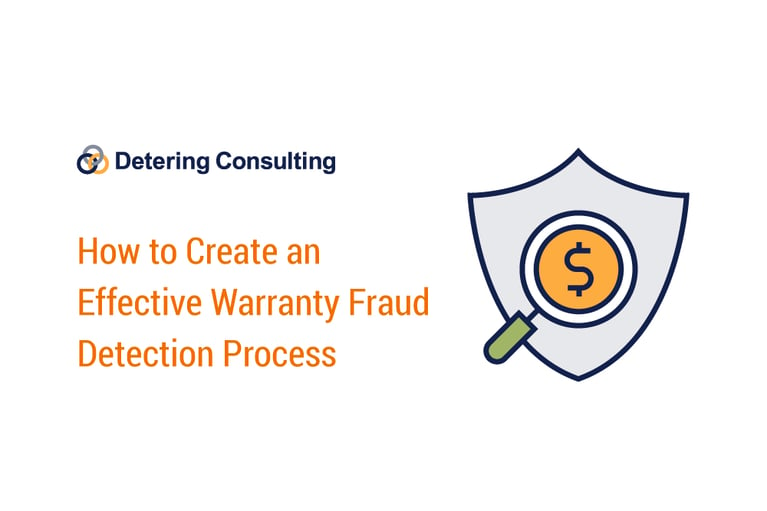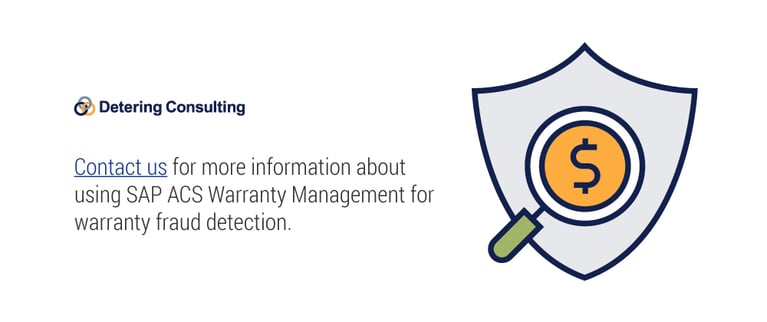By some measures, up to 10% of warranty costs are fraudulent. Although this seems high, this estimate includes fraud by customers, authorized service providers (ASPs), and dealers. A warranty fraud scheme might have been difficult to detect in the past. Individual auditors would have examined service and parts records and compared them against filed warranty claims.

However, warranty process automation and data analytics have enabled manufacturers to detect warranty abuse with far fewer auditors than in the past. Learn how software like the SAP ACS Warranty Management solution can help your business develop a warranty fraud detection system.
What is a Warranty Fraud?
To understand warranty fraud, a brief background of warranty claims is needed. Warranties are terms of a contracts that accompany the sale of most products. Under a warranty, a manufacturer agrees to repair or replace a defective product, subject to certain limitations. Often, limitations are directed to time or usage – a 90-day warranty or 50,000-mile warranty, for example.
Warranties may also be limited to certain types of defects and may exclude damage caused by misuse. For example, a “bumper-to-bumper” vehicle warranty might exclude light bulbs, filters, brake pads, and other parts intended to be replaced. Similarly, a vehicle warranty might provide a new radiator if the original radiator had a leak due to a defect, but not due to a crash.
Forms of Warranty Fraud
This background exposes some obvious warranty exploits. Customers and service centers have a wide range of fraud schemes for taking advantage of warranty repairs, including:
- Duplicate claims: A service center submits duplicate claim for the same VIN or equipment inadvertently.
- False claims: A service center creates a false claim for a non-existent product.
- False defect: A service center colludes with a customer to submit a warranty claim for a covered defect when, in fact, the actual defect is not covered by the manufacturer warranty.
- False date: A customer and service center collude to submit a back-dated warranty claim to fall within the warranty period.
- False reason: A customer or service center conceals the reason a part failed so that the repair can be authorized under the warranty coverage.
- Pre-replacement of parts: A service center and customer file a warranty claim to repair a part that has not yet failed.
Who Benefits from Warranty Fraud?
When a warranty claim is approved by a manufacturer, the manufacturer sends a replacement part, at the manufacturer’s expense, to the service center. The manufacturer also reimburses the service center for the labor to perform the warranty repair.
A fraudulent warranty claim, therefore, pays the service center for repairs that either did not occur or was performed for a different defect. Moreover, the customer or the service center receives a spare part that can be either held or sold.
How Does Warranty Fraud Detection Work?
Warranty fraud detection is undertaken by the manufacturer to ensure that it is only covering legitimate warranty claims entitlements. Warranty checking usually includes three steps:
- Warranty entitlement check: The manufacturer checks to see if the product is under warranty and whether the repair falls within the warranty’s scope and term.
- Defect check: Documentation of the defect is checked to verify that the defect exists.
- Fraud detection: The warranty claim is compared to other claims from the customer and service center to look for suspect claims.
These steps can be conducted manually or automatically.
Is Manual Warranty Checking Effective Enough?
Customers and service centers engage in this type of fraud because the way warranty claims are processed. A warranty claim from a service center is first checked against the customer records and warranty limits. When handled manually, this process can often allow claims that should be stopped just because details are missed.
However, these manual checks are even less effective when the claim includes fraudulent warranty data. For example, if the claim is backdated to fall within the warranty term, the claim will look legitimate during a manual check that may process the claim days or weeks after the repair was already completed.
More importantly, manual checks for fraud detection are limited in their ability to find patterns in the data that would only become obvious when looking at a large volume of claims data over time. For example, a dealership or service center may process hundreds of warranty repairs per year, with fraudulent claims numbering less than one hundred.
How to Prevent Warranty Fraud with SAP ACS Warranty Management Solution
Warranty claims can also be checked automatically using rules-based algorithms that check for warranty entitlement. For example, the SAP ACS Warranty Management solution provides a dealer portal to submit warranty claims and manage the claims process. The service center inputs data into a form to identify the product and the nature of the defect.
Find and Compare Product and Customer Information
From the start, the SAP ACS Warranty Management solution is tailored for detecting anomalies. When the service center enters a part serial number or customer record, the system can compare the information against SAP’s master database to ensure that the part and customer exist. If the part or customer does not exist, or the part and customer are not tied to each other in the database, additional information may be required before approval.
Because the dealer portal operates in real time, backdating of warranty claims is not possible. This means that warranty claims that are time-barred from warranty service cannot be approved. Moreover, the dealer portal requires documentation of the defect. If the defect is not documented, the service center can be required to supply additional information.
Use Advanced Warranty Analytics for Warranty Fraud Detection
Beyond checking for warranty entitlement, warranty analytics can be used to identify long-term patterns in a service center’s or customer’s warranty claims. These patterns can identify anomalies that may indicate warranty fraud.
For example, if one service center or dealership conducts many more fuel pump repairs than other service centers, it may indicate a systemic problem with fuel pumps or warranty fraud. Similarly, if a service center repairs newer compressors just as frequently as it repairs older compressors, the newer compressors might be defective, or the service center is defrauding the manufacturer.
This process of detecting warranty fraud is facilitated by SAP ACS Warranty Management. The dealer portal collects warranty data to be analyzed using the standard SAP data visualizations to set a benchmark and identify anomalies. Thus, you can easily check suspicious warranty claims from service centers experiencing product failure rates much greater than the rate observed generally.
Keep Your Business Running with a Warranty Fraud Detection Solution
Warranty fraud does not just save your business money in fraudulent repairs and replacement parts. Eliminating warranty fraud makes your warranty processing more efficient. Further, without fraudulent claims distorting your statistics, you will be able to focus on failures that truly are occurring, thereby improving product quality.
Contact us for more information about implementing and using SAP ACS Warranty Management for warranty fraud detection.

